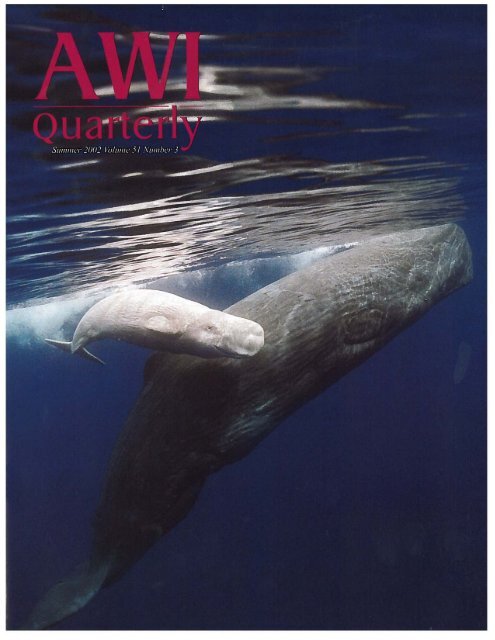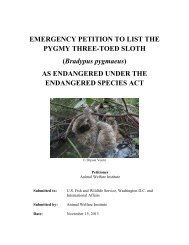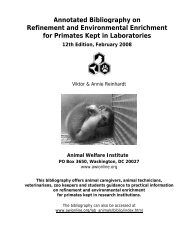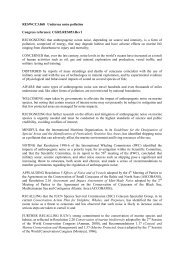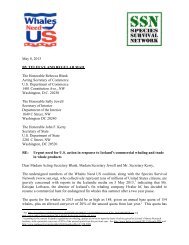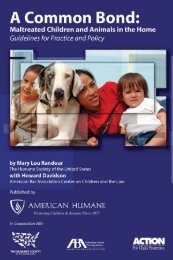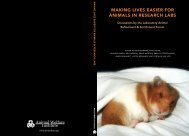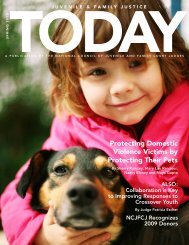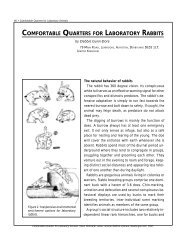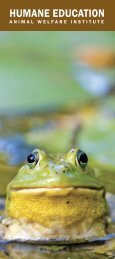My Fine Feathered Friend - Animal Welfare Institute
My Fine Feathered Friend - Animal Welfare Institute
My Fine Feathered Friend - Animal Welfare Institute
- No tags were found...
You also want an ePaper? Increase the reach of your titles
YUMPU automatically turns print PDFs into web optimized ePapers that Google loves.
ABOUT THE COVERSighted off the Azores in the North Atlantic, an extremely rare 13-foot-longwhite sperm whale calf swims with his mother. Sperm whales are the largesttoothed whales- adult males can be fifty feet long and weigh forty tons. PhotographerFlip Nicklin could not determine whether this real-life baby "MobyDick's" eyes were pink, but the calf appears to be a pure albino. Despite hisdolphin smile he's in grave danger from his mother's milk, which may becontaminated by absorbed chemicals, heavy metals, and other noxious substances,as a result of ocean pollution. Other threats come from ship strikes,being caught in entangling fishing nets, and whaling. The Japanese kill spermwhales today under the guise of "scientific research," but whale meat and oilend up for sale in Japan. In May 2002, Japan hosted a remarkably contentiousmeeting ofthe International Whaling Commission, established in 1946to regulate commercial whaling. (See story pages 4-5.)DIRECTORSMarjorie CookeRoger Fouts, Ph.D.David 0. HillFredrick HutchisonCathy LissChristine StevensCynthia WilsonOFFICERSChristine Stevens, PresidentCynthia Wilson, Vice PresidentFredrick Hutchison, CPA, TreasurerMarjorie Cooke, SecretGiySCIENTIFICCOMMITTEEMarjorie Anchel, Ph.D.Gerard Bertrand, Ph.D.F. Barbara Orlans, Ph.D.Roger Payne, Ph.D.Samuel Peacock, M.D.INTERNATIONALCOMMITTEEAline de Aluja, D.M.V., MexicoAmbassador Tabarak Husain, BangladeshAngela King, United KingdomSimon Muchiru, KenyaGodofredo Stutzin, ChileAgnes Van Volkenburgh, D.V.M., PolandAlexey Yablokov, Ph.D., RussiaSTAFF AND CONSULTANTSAva Armendariz, Publications CoordinatorAmy Conklin, Editorial AssistantJohn Gleiber, Assistant/a the OfficersDiane Halverson, Farm <strong>Animal</strong> AdvisorChristopher J. Heyde, Research AssociateLynne Hutchison, Executive SecrelaiJ'Cathy Liss, Er:ecutive DirectorNell Naughton, Mail Order SecretaiJ'Greta Nilsson, Wildlife ConsultantViktor Reinhardt, D.M.V., Ph.D.,Laborat01y <strong>Animal</strong> AdvisorJennifer Rinick, Research AssistantAdam M. Roberts, Senior Research AssociateWendy Swann, Research AssociateBen White, Special Projects ConsultantTake a Bite Out of the Toothfish TradeSince AWl first reported on the serious conservation implications of theinternational trade in Patagonian Toothfish last winter, a concertedglobal effort has taken hold to curtail the commercialization of this fish,often marketed under the name, "Chilean Sea Bass."It is estimated that overfishing and illegal catches could push thePatagonian toothfish to extinction in five years. As well, countless thousandsof sea birds including albatrosses and petrels die cruelly eachyear in this long-line fishery.Almost 10,000 metric tons of Chilean Sea Bass were imported intothe United States in 2000, but the National Environmental Trust (NET)reports that as much as 80% of the catch may be from pirate fishers operatingoutside the law.Two campaigns are underway to save the species: a consumerboycott and a listing under the Convention on International Trade in EndangeredSpecies of Wild Fauna and Flora (CITES). The NET has beguna "Take a Pass on Chilean Sea Bass" campaign, urging restaurants tostop serving the otherwise popular fish. Already, high-end restaurantsin New York and Washington have pledged to stop serving ChileanSea Bass. More than 500 chefs across the US are on board. Todd Grayof the Equinox restaurant in Washington, DC, told the EnvironmentalNews Service, "Not serving Chilean Sea Bass is the right thing to do. Ourguests strongly support us because they agree that it's not worth sacrificingan entire species for our short term appetites."As the campaign continues, the Government of Australia has announcedthat it will propose listing the toothfish on Appendix II ofCITES. Such a listing will not ban commercial trade but will require thatproper export permits accompany each shipment, certifying that eachcatch is legal. According to Dr. David Kemp, Australia's Federal Ministerfor the Environment and Heritage, "it is my view that what is at stakehere is important enough to warrant the use of every available tool. ACITES listing is another string to the bow, another part of the effort."CITES Parties will meet in Santiago, Chile this November.YOU CAN MAKE A DIFFERENCEDon't order Chilean Sea Bass, and if you see it listed on a restaurantmenu, urge the restaurant manager to remove it. -l:t
<strong>Animal</strong> Welfg,re <strong>Institute</strong>QUARTERLYSummer 2002 Volume 51 Number 3TABLE OF CONTENTSMARl N E AN I MALSTake a Bite Out of the Toothfish Trade ... 2Japan Stymied on Home Turf: IWC 2002, by Ben White .. .4-5New Book by Whaler Exposes Cheating ... 5Corral the Coral Trade ... 20Zebra and other animals werekilled with AK-47s while drinkingfrom natural dams in Loliondo.(See story pages 8-9.)WILDLIFE AND SUSTAINABLE DEVELOPMENTEnvironmental Crime- the Globe's Second largest Illegal Enterprise? ... 6Australia Serves up Increased Kangaroo Exports ... 7Koalas Must be Protected ... ?The Killing Fields of loliondo, by Meitamei Ole Dapash ... B-9Elephants Still Under the Gun, by Adam M. Roberts .. . 10-11Jose lutzenberger, a Man of Principle and Wisdom .. . 19LABORATORY ANIMALSNABR's Misinformation Cripples <strong>Animal</strong> <strong>Welfare</strong> and Scientific Integrity,by Christopher}. Heyde .. . 1 4-1 5One of the rescued wild elephantorphans, lcholta, takes a cool mudbath. (See story page 12.)FARM ANIMALSAWl's Pig Husbandry Program Sets a National Standard ... 16Considering Cruel Chicken Confinement ... 17<strong>Animal</strong> Factories Don't Want You to See Their Cruelty ... 17Congress Wants the Humane Slaughter Act Enforced ... 1715,500,000 laying Hens at Stake ... 18A SPECIAL CHIMPANZEEMoja the Artist, by Dr. Roger and Deborah Fouts .. . 1 3AWl PUBLICATIONSComfortable Quarters for Laboratory <strong>Animal</strong>s ... 1 5Chefs and environmentalistsendorse AWl's criteria requiringthat pigs be allowed to behavenaturally. (See story page 16.)BOOK REVIEWSWild Orphans, by Adam M. Roberts .. . 1 2<strong>My</strong> <strong>Fine</strong> <strong>Feathered</strong> <strong>Friend</strong>, by Christine Stevens .. . 1 8Contact AWl at: PO Box 3650, Washington, DC 2002 7, phone: (202) 337-2332,facsimile: (202) 338-9478,email: awi@awionline.org or visit AWlS website at: http://www.awionline.org
A whale threatened Kaikyo Messe, the venue of the 54th annual meeting of the International Whaling Commissionin Shimonoseki, southwestern japan, Friday, May 24, 2002. Ben White of the <strong>Animal</strong> <strong>Welfare</strong> <strong>Institute</strong> constructedthis image of a sperm whale himself as a protest against japanese and Norwegian attempts to resumecommercial whaling. He was inside the whale on the final day of the IWC meeting.Japan Stymied on Home Turf: lWC 2002BY BEN WHITEThe combative tenor ofthe 54th annual conference ofthe International Whaling Commission (IWC) was setthe day before the opening gavel struck on Monday,May 20 in the whaling city of Shimonoseki, Japan. Just offthe bullet train from Tokyo, I was met by a huge and raucousdemonstration of thousands of ultra-right Japanese nationalistscircling the streets in 160 big, black busses with loudspeakersblaring from their roofs. In a deafening call-andresponse,one speaker would shout through his microphone,then 159 others would shout into theirs. Advocating the fullscale resumption of commercial whaling, the demonstratorsplayed martial music from World War II days and chanted"Greenpeace Go Home." The group embraces modem Shintoand believes that the Emperor of Japan is a deity. Ironically,Old Shinto is an ancient religion that believes that streamsand forests and, presumably, whales are sacred.As it turned out, irony was the one constant of a topsyturvyweek. I never would have thought that a pivotal meetingin a whaling center would result in:JAPAN• failing to win a resumption of commercial whaling throughthe adoption of a toothless "revised management scheme";• blocking whaling by opposing the US/Russian proposalfor an aboriginal subsistence quota of bowhead whales forthe Inuits;• failing to win acceptance of its bid, submitted every yearsince 1984, to allow four coastal towns to take 50 minkewhales a year in a commercial hunt- Japan said it would allowthe hunting anyway under the heading of"scientific whaling";• failing to win a simple majority in its annual request for asecret ballot to hide its bought votes, despite its recruitmentof four new countries to vote its way this year (Benin, Gabon,Mongolia, and Palau);• failing in its effort to force the acceptance oflceland intothe commission (Iceland is insisting that it be able to joinwith a reservation on the moratorium on commercial whaling,even though it voted for the moratorium before quittingthe IWC ten years ago);41 AWl QUARTERLY
• succeeding in blocking the adoption of a new South PacificSanctuary, a success tempered by the adoption of sanctuariesby New Zealand, Australia, and other Pacific nationswithin their own waters (extending 200 miles); andTHE UNITED STATES• losing, in the most dramatic IWC slap at the country since1972, the Alaskan Inuit bowhead quota- aboriginal subsistencewhaling quotas are almost always agreed to by consensus(this time the bowhead quota was held hostage by theJapanese linkage with its own perennially rejected requestfor a commercial coastal whaling allotment of 50 minkewhales; its message was 100% po1iticaljousting: if we don'tget what we want, you don't get what you want);• giving in on the hotly contested issue of increasing St.Vincent/Grenadine's annual quota of humpback whales fromtwo to four, despite its repeated illegal slaughter of motherand calf pairs (a deal struck in a private commissioner'smeeting appeared to give St. Vincent its quota if the US andRussia got their bowhead quota, but once the St. Vincentquota was approved, the whalers reneged);• seeing its two primary skeletons in the closet- Makahwhaling and low frequency active (LFA) sonar--openlyquestioned in the plenary. Mexican commissioner AndresRosental, who emerged at this conference as the whales'strongest champion, objected both to the Makah beinggranted whaling rights without demonstrating nutritionalneed and to the joining of the US and Russian request to takegray whales, avoiding the Makah quota passing muster on itsown. The safety ofLFA was brought up by the members ofthe scientific committee and their concerns passed on by theirchairwoman. In response, alternate US commissioner MikeTillman gave a deadpan reading of a statement attesting thatthe effect of LFA on marine mammals will be minimal.THE CONSEQUENCESEven though the IWC has long been derided justifiably asthe whalers' club, its mandate is actually both to conservewhales and to facilitate whaling, a mandate that could beargued is self-contradictory. Those wanting whales protectedare looking, as always, beyond the 48-member IWC to themeeting this fall of the 158-member Convention on InternationalTrade in Endangered Species (CITES). The concernis that if the IWC is seen to be losing its grasp on its abilityto regulate and control ("allow") whaling, then CITES couldstep in to approve the "down listing" and trade of certainspecies of whale. Indeed, over the past several years theincreasingly combative Japanese delegation appears to followa strategy of tying the IWC in knots so it can then go toCITES and say that the IWC isn't working.This year, with the Japanese intransigence at the meetingbeing so dramatic, the argument will be easier to makeat CITES that it is the Japanese who are obstructing progresswithin the IWC, and that they should not be rewarded by supercedingthe responsibilities of the IWC and allowing whalemeat trade while there is a commercial moratorium in place.The issue that might make the whole argument on whalingmoot is the increasing awareness in Japan that muchwhale meat and almost all dolphin meat (often labeled aswhale meat) is contaminated heavily with mercury and otherheavy metals. Having suffered a disastrous bout of mercurycontamination in Minamata Bay in the 1970s, Japaneseconsumers are very concerned with food safety. For thefirst time, 30% of the whale meat obtained through Japan's"research whaling" went unsold last year. An April poll publishedin the Asahi Shim bun newspaper reported that onlyfour percent of those polled ate whale meat "sometimes."The same paper headlined an article, "Changing Tastes MaySink Whaling Fleet," pointing out that despite the posturingand arguing within the IWC, if the Japanese people stopbuying whale meat, the industry will collapse.Just a month before the conference, the Japanese governmenttook the unprecedented step of ruling that the meatfrom five sperm whales could not be sold as human foodbecause it contained 1.4 7 parts per million of mercury, morethan three times the legal limit. To dramatize this action,I made a fifteen-foot tall, sperm whale costume. Workingwith the Japanese group Safety First! I was able to get apermit to walk my whale to the front of the IWC venue onthe last day of the conference. One side of the whale read"WARNING MERCURY," and on the other side was theJapanese translation (the four kangi literally said "SilverWater-Crises-Rough Adventure"). As I approached theconference center inside the costume, the crowd of mediapeeled away from the entrance and surrounded me. One ofthe photographs wound up on page two of the May 28 NewYork Times, illustrating an article entitled "Yuk, No MoreStomach for Whales."One critical outstanding question remains: Will the USallow the Alaskan Inuit whalers to go after bowhead whalesnext spring even if the IWC has not given its permission? -l::New Book by WhalerExposes CheatingIn a bombshell dropped on the eve of the IWC meetingin Shimonoseki, Japan, a longtime coastal whalerwrote a book called the "Rise and Fall of Japan'sCoastal Whaling." The book exposes systematic andrampant cheating by whaling companies, the tendencyof Fisheries Agency's inspectors to turn a blind eye tothe underreporting of numbers of whales caught, andthe exaggeration of the size of immature whales killed.The seventy-five year old author, Isao Kondo toldthe Asahi Shimbun newspaper, "I didn't mean to exposeany secrets from the whaling days of old. I just thoughtI ought to record what actually happened." -l::S U MMO
Environmental CrimetheG [obe 1 s Second Largest lllega[ Enterprise?The earth is full of criminals,some of whom act alone, someof whom act in an organizedfashion, teaming with villainous,nefarious characters. The drug tradelooms as the largest illicit industry onearth with two groups of profiteers vyingfor second place: those who peddlearms and those who commit "environmentalcrimes." The latter bunch,whose blood money nets in the tens ofbillions of dollars annually, were thesubject of a conference hosted by theRoyal <strong>Institute</strong> of International Affairsin London: "International EnvironmentalCrime: The Nature and Controlof Environmental Black Markets."Environmental criminals are degradingour environment and robbing us ofnatural resources.The organizers of the workshopbroadly described five main areas ofenvironmental crime, which comprisethe lion's share of illegal activity: illegalwildlife trade, fishing, logging,trade in ozone-depleting substances,and hazardous wastes. Numerous treatiesexist to control this illegal globalcommerce: the Convention on InternationalTrade in Endangered Species,the Convention on Conservation ofAntarctic Marine Living Resources, theMontreal Protocol and the Basel Convention,to name a few.Environmental criminals are drivenby the high profit/low risk nature oftheir scheming. Smugglers, traders, andtheir profiteering networks are becomingmore and more sophisticated intheir efforts to outdo the governmentstrying to rein them in. Debbie Banksof the Environmental InvestigationAgency (EIA) noted, "environmentalcriminals are better informed andprepared to outwit the authorities andany trade controls that are put in place.They know how to exploit loopholesin the laws and permit systems. Theirknowledge of trade routes and transportsystems means they can adapt quicklyif enforcement authorities do catch upwith them."Frances M. Ole Nkako, the ProjectCoordinator for the Kenya WildlifeService's Bushmeat IdentificationProject added that sophisticated crimenetworks are aided by government enforcementagencies lacking the politicaland financial backing to do their jobswell. Captain Gert van der Merwe of theSouth Africa Endangered Species ProtectionUnit concurred, adding that environmentalcrimes are not deemed as apriority for the police, that staff in manyA US government storeroom of confiscated endangered wildlife items,from big cat skins to polar bear hides and elephant ivory.African countries are trained inadequately,and that the many governmentsin question are rife with corruption.The wildlife trade is a well-knownproblem, especially to readers of theA WI Quarterly, whether it's the tradein elephant ivory, rhino horn, tigerbone, bear gallbladders, whale meat,or live exotic birds for the pet industry.Increasingly, pirate fishing of speciessuch as Patagonian toothfish, describedon page 2 of this issue, is on the rise.Illegal logging takes its toll, destroyingvital habitat for wild species. Captainvan der Merwe notes, for instance, thatthe Cape Parrot in South Africa is criticallyendangered owing in part to "Thedestruction of indigenous yellow-woodforests which lead to high prices for thebirds, and smuggling." There are alsoserious problems with illegal internationaltrade in ozone-depleting substancessuch as chlorofluorocarbons,as much as 20,000 tons of which EIAestimates were produced and tradedfrom developing countries on the blackmarket annually in the late 1990s.There i plenty of blame to goaround for the proliferation and expansionof environmental crimes. Thereare also clear strategies toward reducingthis illegal activity. Internationaltrade should be monitored by appropriateglobal treaties with specific recommendationsand support offered to individualcountries. National governmentsshould provide their agencies the financialbacking and training to enforcethese treaties. Furthermore, they mustdemonstrate the necessary political willto pass adequate legislation with penaltiesin place that give the judiciary astrong hand in deterring environmentalcrime. Consumers must be educatedon the perils of wildlife crime andthe need to abstain from purchasingwildlife and wild products, includingillegal timber. When we purchase blackmarket goods or products potentiallyacquired illegally, we, too, become accessoriesto environmental crime. ~
Australia Serves up increasedl(angaroo ExportsEastern grey kangaroos box at awildlife park in Tasmania.Conservation groups are readyto mount a legal challenge tothe Australian government'sannouncement that its nationalkangaroo quota would leap to 7 million,an increase of more than one and a halfmillion animals. Australia has beenexporting kangaroo meat for over 40years, today to 21 countries. Exportsto Europe have increased predictablyoflate as a result of the European madcow food scare.Some in the Australian governmentquestion the legality and scientificvalidity of the quota increase. RichardJones, a long-time friend of kangaroosand an Upper House member fromNew South Wales, told Australia'sDaily Telegraph newspaper, "I findit astonishing that the minister hasapproved the quota, given its size andthe fact that there has never been anyscientific research to determine howmany grey kangaroos can be killedwithout affecting the population."There are also significant welfareconcerns regarding kangaroo killing.Though the Australian governmentadvocates a "sudden and painlessdeath," Nicola Beynon of HumaneSociety International- Australia,contends, "There is no effective wayto monitor and police methods of killingand prevention of cruelty throughinjuries to animals or abandonment ofJoeys. The naive expectation is thatshooters wait for only certain types ofkangaroos to stand still, in a certain positionand distance from a still vehicleso they can take a perfect aim. The realityis that every shooter is pressuredto take a certain number of kangaroosin whatever way possible to covercosts and demand." ~l(oa[as Must be ProtectedIn April, The Financial Times newspaperreported that the future ofkoalas is the subject of a heatedconservation debate across Australia.After recovering remarkably from thefur trade that pushed them to the brinkof extinction early in the twentiethcentury, koalas now are at risk frombrushfires, road deaths by automobiles,and attacks by people's pets and feralanimals. Most significant, however, arehabitat destruction and human development,which squeeze koalas from theirforest homes. As the Financial Timesstory reports: "The koala problem thenis twofold- lack of places to live andspeed of population growth. Buildingdevelopments and agricultural practiceshave isolated areas of suitable nativebush that have become the equivalentof islands where koala populationshave increased unchecked."In southern Australia, koalas areblamed for literally eating trees todeath. The AustralianKoala Foundation(AKF),however, contendsthat disease iskilling the trees.Deborah Tabart,AKF ExecutiveDirector, portraysthe koala as ascapegoat in thedestruction oftrees in KangarooIsland: "HabitatTaree Bo Bo was rehabilitated by the Koala PreservationSociety in New South Wales, Australia andreleased to the wild.fragmentation,insufficient fire regimes, grazing, logging,farming and edge effects havecontributed to the death of trees onKangaroo Island. It is ridiculous toblame the koalas for the damage peoplehave done."Solutions to the koala conflictmust be sought that do not involveindiscriminately killing these eucalyptus-lovingtree-dwellers. One currentaction is sterilization, by vasectomizingmales. Some koalas are being relocatedto less-crowded areas. A moreappropriate, long-term solution is tolimit land clearing and promote theplanting of new trees. As Ms. Tabartnotes, "There are not too many koalas-there are too few trees."~SUMMER 2002 17
Cheetah are among the vulnerable species in the Loliondo area that are hunted as trophies.The l(i[[ing Fields of Lol1ondoBY MEITAMEI OLE DAPASH,THE MAASAI ENVIRONMENTAL RESOURCE COALITI ONIs this what you call civilization? Killing innocent animals?Well, nature will have to judge you by your actions.- Kailol Ole Pere, Olosira Lukunya/Loliondo residentAn ecological crisis is looming in Loliondo, an area ofMaasai ancestral lands in the northern part ofTanzaniaalong the common border with Kenya. Tanzaniahas become an enormously important destination for trophyhunters from Europe, North America, Asia, and the MiddleEast. Regrettably, Tanzania does not recognize Maasai traditionalland rights or their right to full access and control ofnatural resources.The Ortello Business Company (OBC), a hunting companyfrom the United Arab Emirates (UAE), operates in theLoliondo Game Controlled Area in northern Tanzania witha license that permits hunting of wild game and trapping oflive animals to be flown to the UAE. It appears that OBC hasa long-term agenda for exploiting the high concentration ofwildlife in Loliondo.According to residents ofLoliondo, OBC illegally usesfire to control the movement of wildlife within and aroundthe Loliondo hunting concession. The Maasai EnvironmentalResource Coalition (MERC) has learned that fires usuallyare started at the beginning of the prime hunting season tocoincide with the great ungulate migration, including wildebeests,zebras, elands, hartebeests, giraffes, and buffaloes.OBC ignites fires along the common border area to preventanimals from crossing into Kenya, where commercial huntingis banned and instead forces them to retreat to huntingareas. The halted migration oflarge herds of plains gamealso attracts increased numbers of carnivores- lions, cheetahs,leopards, hyenas, hunting dogs, and jackals. This providesOBC with an opportunity to capture large cats- particularlythe much favored lion, cheetah, and leopard- andtransport them to UAE.OBC also employs baiting, a hunting practice that circumventsthe need for long searches for wildlife, especiallybig cats and hyenas. A common form of baiting used bytourist hunters entails using carcasses to lure animals intotraps. In Loliondo, in addition to carcasses, OBC digs artificialwatering holes and small dams to lure large numbersof mammals and even birds for easy shooting. According toLoliondo residents, OBC relies heavily on small dams duringthe dry season to entice large numbers of thirsty animals.Local guides keep watch and radio to OBC when animalshead in the direction of the dams. The hunters take coverbefore the animals arrive and then strike with machine guns.Night hunting is not a new practice in the world of hunting,but it too is gaining popularity in some parts of Tanzania.In Loliondo, MERC learned that OBC uses powerfulspotlights mounted on vehicles to locate animals at night.Blinded and confused, animals stagger in front of vehicles,making them easy targets. This appears to be an exercise inal AWl QuARTERLY
shooting for fun or practice rather than trophy hunting.Although Tanzanian law only allows tourist hunters tokill males who are no longer active reproductively, OBC personneland guests shoot and capture animals young and old,male and female, lactating and pregnant. Some of the speciesthat the Maasai say they have seen captured include: lion,leopard, cheetah, impala, baboon, vervet monkey, gerenuk,giraffe, hyena, warthog, and bird species, particularly ostrich.In some cases, dead animals are transported in lorriesto nearby non-Maasai communities and sold as bushmeat,potentially encouraging poaching and an illegal market forsuch flesh. Despite the fact that Tanzanian law forbids foreigntourist hunting companies from utilizing game for commercialpurposes, OBC workers take advantage of officialhunts to kill animals for their own consumption and sale inthe neighboring communities. Maasai do not eat wild game.The Maasai ofLoliondo have for a long time accusedOBC of grave human rights abuses and environmental violations.They have described acts of intimidation, harassment,arbitrary arrest and detention, and even torture by OBC officialsand security forces, as well as by Tanzanian police andmilitary in the name of OBC; brazen violations of grazingand land rights; and wanton environmental destruction andextermination of wildlife. They have seen leaders who onceopposed OBC's practices corrupted and bought-off. Theyhave witnessed OBC officials trying to convert Maasai toIslam, with further instruction to abandon Maasai culture.Giraffe are killed illegally for their meat and theirneck sinews, which are used in making bows to shootarrows. They are also captured live for export.Indiscriminate hunting may have caused the declineof to pi and other antelopes in the area.The Government of Tanzania should sanction an independentinvestigation team to examine the numerous complaintsabout OBC's practices in the field and their impactson human rights, wildlife, and the environment. This shouldinclude an examination of the role of Tanzanian securityforces and government officials. The team should be composedof international and Tanzanian experts but should notinclude members of the Tanzanian government due to allegationsof widespread corruption. During the investigation,OBC's hunting privileges must be suspended.The killing of wildlife for sport is in itself an offense tothe Maasai world view. Maasai traditionally believe that thepresent generations hold all natural resources, including theland, in trust for future generations. The killing of wildlifefor pleasure or commercial purposes is not permitted. Maasaibelieve that trophy hunting leads to greed, over-exploitationof wildlife resources, and often irreversible damage to delicateecosystems. Today's East Africa owes much of its wildlifeprosperity to traditional Maasai conservation practices.This invaluable conservation role has gone largely unappreciated-and worse, in the name of modernity, it continues tobe undermined and targeted for elimination.The Maasai tradition must survive despite foreign influencessuch as those of OBC. As Lemido Saunae, a Tarangireresident says, "You know, at the end of the day, they willeliminate these animals and then go back to their wealthyhomelands and leave us more impoverished than when wehad our animals ."~SUMMER 2002 19
shooting for fun or practice rather than trophy hunting.Although Tanzanian law only allows tourist hunters tokill males who are no longer active reproductively, OBC personneland guests shoot and capture animals young and old,male and female, lactating and pregnant. Some of the speciesthat the Maasai say they have seen captured include: lion,leopard, cheetah, impala, baboon, vervet monkey, gerenuk,giraffe, hyena, warthog, and bird species, particularly ostrich.In some cases, dead animals are transported in lorriesto nearby non-Maasai communities and sold as bushmeat,potentially encouraging poaching and an illegal market forsuch flesh. Despite the fact that Tanzanian law forbids foreigntourist hunting companies from utilizing game for commercialpurposes, OBC workers take advantage of officialhunts to kill animals for their own consumption and sale inthe neighboring communities. Maasai do not eat wild game.The Maasai ofLoliondo have for a long time accusedOBC of grave human rights abuses and environmental violations.They have described acts of intimidation, harassment,arbitrary arrest and detention, and even torture by OBC officialsand security forces, as well as by Tanzanian police andmilitary in the name of OBC; brazen violations of grazingand land rights; and wanton environmental destruction andextermination of wildlife. They have seen leaders who onceopposed OBC's practices corrupted and bought-off. Theyhave witnessed OBC officials trying to convert Maasai toIslam, with further instruction to abandon Maasai culture.Giraffe are killed illegally for their meat and theirneck sinews, which are used in making bows to shootarrows. They are also captured live for export.Indiscriminate hunting may have caused the declineof to pi and other antelopes in the area.The Government of Tanzania should sanction an independentinvestigation team to examine the numerous complaintsabout OBC's practices in the field and their impactson human rights, wildlife, and the environment. This shouldinclude an examination of the role ofTanzanian securityforces and government officials. The team should be composedof international and Tanzanian experts but should notinclude members of the Tanzanian government due to allegationsof widespread corruption. During the investigation,OBC's hunting privileges must be suspended.The killing of wildlife for sport is in itself an offense tothe Maasai worldview. Maasai traditionally believe that thepresent generations hold all natural resources, including theland, in trust for future generations. The killing of wildlifefor pleasure or commercial purposes is not permitted. Maasaibelieve that trophy hunting leads to greed, over-exploitationof wildlife resources, and often irreversible damage to delicateecosystems. Today's East Africa owes much of its wildlifeprosperity to traditional Maasai conservation practices.This invaluable conservation role has gone largely unappreciated-and worse, in the name of modernity, it continues tobe undermined and targeted for elimination.The Maasai tradition must survive despite foreign influencessuch as those of OBC. As Lemido Saunae, a Tarangireresident says, "You know, at the end of the day, they willeliminate these animals and then go back to their wealthyhomelands and leave us more impoverished than when wehad our animals."~SUMMER 2002 19
Elephants Still Under the GunBY ADAM M . ROBERTSElephant carcasses once againunceremoniously litter Kenya'snational park lands. KenyaWildlife Service Director J.M. Kiokorecently reported that Somali poachersarmed with AK-47 rifles "ambusheda herd of 11 elephants," massacringall but one. Said Director Kioko, "thisslaughter of a family often elephants isthe largest incident in which an entirefamily of elephants has been poachedsince KWS's establishment in 1989 ....This and other previous incidents inKenya suggest that the ivory marketsare active and poachers are activelyfeeding the illegal trade in ivory."In 1989, the Parties to the Conventionon International Trade inEndangered Species (CITES) votedto give elephants the highest level ofprotection in order to stop commercialtrade in ivory. Since then, a smallminority of southern African nationshave conspired to repeal the ban andprofit from the wanton slaughter ofthese amazing creatures. In 1997 theypartially succeeded- CITES grantedwhat was billed as "a one-time" saleof stockpiled ivory from Botswana,Namibia, and Zimbabwe to Japan. In2000, CITES weakened its protectionfor South Africa's elephants as wellbut refused to allow sale of South Africanivory.Ivory profiteers bank on the prospectthat CITES may someday yieldand allow an unfettered resumptionof the commercial ivory trade. Thisdrives the current killing. Sales from"government stockpiles" are dangerousbecause ivory from poached elephantscan be laundered in with the "legal"stash. The message from any sale, evenfrom stockpiles, is that ivory has value.When poachers and smugglers get theword that money is to be made by illegallykilling elephants and illicitly tradingivory, they inevitably renew theirdeadly dealings.The ivory debate is ready to explodeagain leading up to the nextCITES meeting in November 2002 inSantiago, Chile. Botswana, Namibia,South Africa, and Zimbabwe haveproposed another ivory stockpilesale and advocate an annual exportquota of ivory. According to a Reutersreport, Zambia is also requesting totrade in ivory despite the fact that"Zambia's elephant population hasdwindled from around 200,000 in the1970s to only 26,000 now due to rampantpoaching."These five southern African countriesrepresent a small minority ofthe overall number of elephant rangestates, both in Africa and in Asia. Theelephant range states that recognize thelooming disaster from a reopened ivorytrade have a strong pair of allies in theGovernments of Kenya and India, aduo that is teaming up to propose thatall African elephants be put back onAppendix I of CITES, thus cutting offinternational commercial trade in elephantproducts once more. Their proposalshows that "Poaching of Africanand Asian elephants for their ivory andthe illegal ivory trade continue to posea serious threat to most African andAsian elephant populations," and that"In most cases, existing anti-poachingefforts in Africa and Asia are no matchfor well-armed poachers."The statistics from the most recenttwo years are alarming indeed. Elephantpoaching is extensive across theanimals' range. From January 1, 2000to April 30, 2002, over 1,000 elephantswere poached in the African and Asiancountries ofNamibia, the DemocraticRepublic of Congo, Zimbabwe, Kenya,India, Tanzania, Angola, and Cambo-Elephant herds are led by a matriarch who governs the females. Theymourn family members' deaths when ivory bandits kill them for their tusks.An elephant family is murdered inKenya's Tsavo East National Park.
dia. This includes elephant killing inconservancy lands, national parks,reserves, and wildlife sanctuaries.Despite the current trade ban,elephant ivory is smuggled globally.Kenya and India report illegalivory seizures from January 1, 2000through May 21, 2002 to include 2,542tusks and 14,648 ivory pieces or objects,weighing a total of5,953.4 kg.These seizures are global, showingthe breadth of the international illegalivory trade: Tanzania, Chile, South Africa,Kenya, Namibia, India, Thailand,the United Kingdom, the United States,Zambia, Djibouti, China, Uganda,Belgium, Botswana, Switzerland, theNetherlands, Egypt, the DemocraticRepublic of Congo, Japan, Cameroon,Taiwan, Vanuatu, and Canada.One report alleges that a manfrom Oman was arrested for trying tosmuggle 60 large ivory pieces weighingapproximately 400 kilograms intoThailand. A Gambian national was sentencedin March 2002 to one year anda day in a US federal prison for conspiringto smuggle 66 ivory pieces intothe US from Nigeria. Four huge ivorycarvings were seized in the IndianState ofKerala, including one that wasnearly four feet tall. "One of the carvingswas rather ironically of Ganesh,the Hindu elephant god of wisdom andsuccess," noted Belinda Wright, ExecutiveDirector of the Wildlife Protec-tion Society of India. Wright continued,"This case illustrates the extent ofthe illegal ivory trade. It is extremelyalarming and does not bode well forthe future of wild elephants."Much of the blame for this traderests with ivory consumers who fuelthe market. A recent report on TheSouth and South East Asian Ivory Markets,published by Save the Elephants,shockingly reveals that "Wild elephantpopulations in Cambodia, Laos andVietnam from 1988 to 2000 have declinedby over 80% ... largely due tothe trade in ivory and other elephantproducts." The authors surveyed eightAsian counties and found over 105,000ivory items available for retail sale.Asian elephant experts met inCambodia in May of 2002 and approveda resolution recommending"that all proposals that encouragedirectly or indirectly a re-opening oftrade in ivory be discouraged and thatparties to the CITES vote to continuethe present international trade ban onivory and that they do not support anydown listing proposals of African elephantpopulations."The clear answer is the most simple:protect all elephants completelyfrom international trade in their partsand products, particularly ivory. Thepermanent cessation of the ivory marketis essential to the long-term viabilityof the global elephant population.~WHAT DO THEY WANT?Botswana: Trade in hunting tro·phies, live animals, hides, leathergoods, ivory carvings, and a saleof 20 metric tons of ivory initial·ly, followed by an annual allowedsale of 4 metric tons.Namibia: Trade in hunting tro·phies, hides, leather goods, ivorycarvings, and a sale of 10 metrictons of ivory initially, followed byan annual allowed sale of 2 met·ric tons.South Africa: Trade in huntingtrophies, live animals for re-introduction,hides, leather goods, anda sale of 30 metric tons of ivoryinitially, followed by an annual allowedsale of 2 metric tons.Zambia: Trade in live animalsand a sale of 17 metric tons ofivory.Zimbabwe: Trade in huntingtrophies, live animals, hides,leather goods, ivory carvings, anda sale of 1 0 metric tons of ivoryinitially followed by an annualsale of 5 metric tons.Kenya & India: All elephantpopulations, including Botswana,Namibia, South Africa, Zambia,and Zimbabwe, get full protectionon Appendix I of CITES.Ganesh, the Hindu elephant god ofwisdom and success.Kenya Wildlife Service rangers carrying buried ivory tusks.
Photographs and Text by Gerry EllisWelcome Books 2002ISBN: 0-941807-58-4; 136 pages; $24.95BY ADAM M. ROBERTSing mud bath. The babies' surrogate mothers feed them milkfrom a bottle hidden behind a blanket draped between thetrees, thus emulating the feeling ofbeing under a mother'sbody while drinking. The caretakers even sleep alongsidetheir elephantine children, waking with them often throughoutthe night.Ultimately, the orphans reach an age that they can be releasedto the wilds ofTsavo National Parle. Ellis returned tosee "his" elephants in Tsavo nearly a year after their releaseand greeted them with the astonishment of a human parent:they were heavier orne 200 pounds rounder- and had begunsprouting their precious ivory tusks. Ellis notes: "WhenI saw Natumi with her thumb-size tusks poking out from herupper jaw, I felt the joy a parent must feel when their childsheds baby teeth for those of adulthood."Of course, these "adult teeth" put elephants at greatperil across Africa. The ivory trade cut the continent-wideelephant population in half leading up to the 1989 decisionby the Convention on International Trade in EndangeredSpecies to protect elephants and stop the international commercialivory trade.Ellis is acutely aware that elephants are still under thegun by ivory poachers: "But it is Natumi's new tusks thatworry me most about her future. As she matures and thoseelegant sweeping tusks grace her profile, their price tag willgrow to a bounty of several hundreds or thousands of dollars.Although Tsavo is protected, poaching still goes onwithin the park. Only the vigilant refusal of people aroundthe world to buy ivory offers her any true security."~Natumi, Icholta, Ilingwesi, Nyiro, Lolokwe, Salama,Laikipia, and Edie--eight orphaned baby elephantswho collectively became known as the "Orphan8"- form the basis of Gerry Ellis's delightful book WildOrphans. Ellis uses over 100 of his brilliant color photos todepict the early development of these babies, from rescuethrough rehabilitation to release in the wild.Baby elephants may be orphaned when their mothers aregunned down by poachers' bullets, when they are deemed"problem" animals, or when they inadvertently get stuck inwells or other watering holes. The lucky survivors are takento Dr. Daphne Sheldrick's Wildlife Trust orphanage outsideKenya's capital, Nairobi, where they most lovingly are caredfor around the clock. Dr. Sheldrick notes in her Forewordto the book that "elephants are worthy of, and need, humancompassion and understanding," and "that they must be handledwith sensitivity and care rather than brutality."The youngest child or the most learned scientist shouldappreciate Ellis's heart-warming pictures and simple accompanyingtext, which tell a story of utter compassion. Whenthey arrive, elephant babies may be emotionally distressed,physically injured, dehydrated, sunburned, or cut by snares.The caretakers at the orphanage show what Ellis simplydescribes as "endless patience" in caring for them. The elephants'human adoptive parents play with them (physicalcontact for which the elephants yearn) and introduce them tothe shallow pools that provide them with a welcome, cool-Caretaker Benson and elephant Natumi share an expressionof humor and joy.12 J AWl QUARTERLY
Moja the ArtistBY DR. ROGER ANDDEBORAH FOUTSMoja enjoyed looking at herselfin a mirror in fancy dress.She loved climbing, swinging,running, and playing peekaboo.Her favorite foods included onionsand farina. As of Thursday, June 6,2002, Moja no longer will be able totake advantage of these simple lifepleasures. All of us at the Chimpanzeeand Human Communication <strong>Institute</strong>(CHCI), Central Washington University,were devastated to learn that Mojadied suddenly, at age 29, after beingill for only two days. She is the onlychimpanzee to die at CHCI.All of the chimpanzees at CHCIhave been as upset as the humans. Tatusigned HURT and CRY to us, and Darhas been signing CRY as well. Washoehas seemed very introspective and hassat looking for a long time into thenight enclosure area where Moja died.Washoe, abducted from the Africanjungle to become part of the Americanspace program, was the first nonhumanprimate to learn to speak sign language.She also helped Moja grow upwhen she first came to our facility.It took Moja about a year to adjustto life at CHCI, mostly as a result ofWashoe's oversight. Once she "cameout," there was no question that shewas the chimpanzee who did notknow how to act like a chimpanzee.She was described this way in Next ofKin: "Moja was easy to engage if onebrought along the right fashion accessories.She was extremely consciousof her appearance, and there was nothingMoja loved better than putting onan old dress, shoes, and makeup andstudying herself in the mirror. Sheinsisted on red dresses, but she wasn'tchoosy about her footwear. The irrigationboots we wore to clean the cagesmade her just as happy as party shoes.After she was dressed she would askus to brush her long hair, which couldkeep her entertained for hours." Oneperson told us that while driving by hewas so distracted by the sight ofMojain a scarlet negligee swinging aroundthe top of the outdoor enclosure hedrove up on the curb!As far as we know Moja was thefirst chimpanzee to employ representationalart. When she was in Renoand she'd done a drawing, her humancompanion thought she was wastingpaper because it wasn't filled up. Sothe paper was returned to her and shewas asked to DRAW MORE, to whichshe replied FINISHED. After this exchangewent back and forth for awhileshe was asked what she had drawnand she replied BIRD. The schematashe used then was the same one shecontinued to use later when she drewpictures ofbirds.Moja was the first chimpanzeeof a second sign language project byDrs. Beatrix T. and R. Allen Gardnerand she was born in captivity at theLaboratory for Experimental Medicineand Surgery in Primates (LEMSIP).Hence, her full name was Moja Lemsip("Moja" is the Swahili word for"first").In the wild, chimpanzees can liveinto their forties, but in captivity, manydie between ten and fifteen years ofage. Although our lives were enrichedby knowing Moja, chimpanzees do notbelong in captivity. Captivity is notgood for them. Our species has yet tolearn that lesson. ~Left: Painting by Moja entitled ''Name This."Above: Moja 's drawing of the wings of a bird in flighttransformed this human sketch of a banana given to herby a visitor.
NABR!s Misinformation Cripples <strong>Animal</strong><strong>Welfare</strong> and Scientific integrityBY CHRISTOPHER -.J. HEYDEAccording to the US government's primary animalprotection law an estimated 25 million birds, ratsand mice being experimented on each year in US researchfacilities are no longer considered "animals." In 1970,Congress amended the <strong>Animal</strong> <strong>Welfare</strong> Act (AWA) to ensuredecent care and treatment for all warm blooded animalsused for experimentation, testing and teaching. This year,however, one US Senator took it upon himself to weaken theAWA by excluding birds, rats and mice from the Act. Birds,rats and mice, who comprise approximately 95 percent of allanimals used in research, have now been denied protectionunder the law (see Winter 2001 AWl Quarterly).In one of his last acts as a Senator, Jesse Helms (R-NC)handed the National Association for Biomedical Research(NABR) an objective it has pursued since its foundingby the president of the world's largest laboratory animalbreeder, Charles River Laboratories, over 20 years ago-theevisceration of the AWA. NABR and its preceding organizations(the National Society for Medical Research and theAssociation for Biomedical Research) have opposed everypiece of legislation to protect animals in laboratories introducedin Congress.Through a campaign of misinformation and hysteria,NABR convinced Helms to ignore overwhelming scientific,Congressional, judicial, public and international support forthe protection of these animals. Apparently, Helms and hissupporters disregarded the only scientific survey conductedon the subject by scientists Harold Herzog of Western Caro-This was the 259'h rat to receive an injection to thebrain- not a single virus had appeared and as the re·searcher put it, "it's not working."The necks of these mice and 21 others were crushedwith a metal cage-card holder in violation of UNCpolicy and NIH guidelines. One mouse was found paralyzedand alive in the dead-animal cooler.!ina University and Scott Pious of Wesleyan University, inwhich 73.9 percent of researchers who were polled supportedthe inclusion of rats and mice under the AWA and 67.9 percentsupported inclusion of birds. An informal survey conductedby Dr. Harry Rozmiarek, Chief Laboratory <strong>Animal</strong> MedicineVeterinarian at the University of Pennsylvania also shows theoverwhelming support of laboratory animal veterinarians.Several researchers present at NABR's national conferencein May oflast year reported that a poll, by show of hands, revealedthat the vast majority of those in attendance supportedinclusion of birds, rats and mice under theAWA, but the Associationquickly denied any such survey took place.NABR convinced Helms that Congress never intendedthe AWA to provide protection to these animals despite 30years of clear legislative intent, the law itself, and judicialaffirmation of that law. Former US Senator Bob Dole, whosupported the 1970 amendment to the AWA and sponsoredits 1985 amendments, wrote in support of including birds,rats and mice under the Act stating "that the AWA appliedto 'all warm blooded animals,' we certainly did not intendto exclude 95 percent of the animals used in biomedical researchlaboratories."As Helms stood on the Senate floor and professed thatthere was no need for AWA protection, multiple reports ofanimal mistreatment and abuse surfaced at major researchinstitutions/universities, shining more light on the urgentneed for USDA oversight. Reports from the University ofNorth Carolina at Chapel Hill (UNC-CH), University ofConnecticut and the University of California at San Franciscodetail horrendous apparent violations of National14 1 AWl QUARTERLY
<strong>Institute</strong>s of Health guidelines. In fact, videotape recordedbetween October 200 I and April 2002 and released by Peoplefor the Ethical Treatment of <strong>Animal</strong>s shows a UNC-CHresearcher using scissors to cut the heads off conscious, unanesthetizedyoung rats before removing their brains. On thetape he states that he knows this is a violation of his protocolsubmitted to the Institutional <strong>Animal</strong> Care and Use Committee,but ignores it for his convenience. The video also showsan apparent lack of adequate veterinary care with numerousmoribund rodents left suffering until they died. Repeatedly,mice, who were supposed to have been killed, were foundalive in the dead animal cooler and a staff person describeshow he found "a whole slew of rats" alive in the cooler.At the University of Connecticut rats were found deadand dying in a room that was 94'F. Chickens were left withoutproper air circulation and suffocated. In April2001, twoof four crates of newly received mice were damaged andopen with mice dead and missing. An employee at the Universityof California in San Francisco anonymously reported"For the third time in just over one month, live mice werefound in the dead animal freezer, indicating improper euthanasiatechnique (failure to follow C0 2narcosis, with physicalmethod such as cervical dislocation)."The numbers of birds, rats and mice being used in researchis expected to grow exponentially with use oftransgenicsand other new avenues of research. Now, more thanever, protections are needed to ensure humane treatment ofthe tens of millions of animals used for experimentation, andto prevent scientific fraud as a result of poor care, neglector abuse of the animals. One would hope that the scientificresearch community and Congress would realize that NABRis not representing the interests of scientific advancement orhumane animal care, but is in fact detrimental to both. ~Protocols at the UNC forbid tumors larger than 2 em,however, it was common to find mice whose tumorswere much larger.CORRECTION: In the 2002 Spring Quarterly, the photographthat appeared with "Forcibly Breaking the MaternalBond" was taken by Peter Hamilton.COMFORTABLE QUARTERSfor f2aGoratorg ..!ltnima!sEdited by Viktor and Annie Reinhardt<strong>Animal</strong> <strong>Welfare</strong> <strong>Institute</strong>, Ninth Edition, 2002ISBN: 0-938414-02-X; 114 pagesAWl has completedpublication of anew edition of ComfortableQuarters forLaboratory <strong>Animal</strong>sto promote the humanehousing andhandling of the millionsof animalsused each year inresearch facilities.Edited by A WI'sscientific advisor,Dr. ViktorReinhardt andhis wife, Annie,this isAWl's ninth editionof the book, which was firstpublished in 1955. We provide copies free on requestto scientific institutions, members oflnstitutional<strong>Animal</strong> Care and Use Committees, veterinarians, andarchitects. It is available to others at cost price, $5.00.This volume is an essential tool to ensure that eachspecies used in biomedical research or testing is housedappropriately and cared for with the greatest attentionto the animals' welfare. As Professor David Morton,Head of the Centre for Biomedical Ethics at England'sUniversity of Birmingham, notes in his Foreword, "attemptingto meet [animals'] needs and avoiding adversemental or physical states, such as boredom, frustration,pain, distress, can only be to the benefit of both the animalsand science."The new edition comes out at a pivotal time in thequest to achieve humane treatment of animals in laboratories-a time when Congress has legislated the biologicallyand scientifically indefensible notion that rats,mice, and birds are not animals deserving minimal careunder the law. As the Reinhardts aver in their Introduction,"We see no scientific, ethical or logical justificationfor this seemingly arbitrary justification."This comprehensive 114-page book includes chapterson comfortable quarters for mice, gerbils, rats, hamsters,guinea pigs, rabbits, cats, dogs, primates, pigs, sheep,cattle, horses, chickens, amphibians, and reptiles. ~
AW1 1 s Pig Husbandry Program Sets aNational StandardAmodest collaboration that began in 1997 betweenthe <strong>Animal</strong> <strong>Welfare</strong> <strong>Institute</strong> (A WI) and one familyfarmer has, in 2002, become a national program withnearly 200 farmers adhering to A WI's Humane On-Farm PigHusbandry Standards. Although the standards were developedto preserve the welfare of pigs, they appeal to an array of organizationswith diverse interests.Nowhere was this more apparent than in Manhattan, onMay 9, 2002, when America's leading chefs and environmentalistsgathered to endorse A WI's standards. The press event,held at Blue Smoke/Jazz Standard, included an overview ofAWl's standards and footage contrasting sow factories withhumane farms. Paul Willis, a farmer from Niman Ranch, oneof the nation's leading purveyors of products from humanefamily farms, and Bill Niman, co-founder ofNiman Ranch,testified that AWl's standards are the best for both animalsand farm families. Leaders from Waterkeeper Alliance, SlowFood USA, Chefs Collaborative, Earth Pledge Foundationand Global Resource Action Center for the Environment(GRACE) announced why they endorse AWl's standards.These groups recognize the importance of protecting pigwelfare, but they see additional merit in the standards: protectingwater quality, revitalizing a culture of traditional,sustainable family farms and protecting the effectiveness ofantibiotics in human and veterinary medicine. Chef MichaelRomano made an impassioned statement:"Good morning! I am Michael Romano, one of the proprietorsof Blue Smoke/Jazz Standard, and along with mypartners, Danny Meyer, David Swinghamer, Paul Bolles-Beaven,Richard Coraine, as well as our Executive Chef Ken Callaghan,please allow me to welcome you wholeheartedly toour new restaurant. We are very pleased to host this breakfast."It strikes me thatwhat you all are abouthere is some terriblyimportant work ....I tooka wonderful visit to theIowa home of Paul Wilisand his family. I was veryimpressed not only by thegracious hospitality ofmy hosts, but also by the§' pigs we met out in Paul's.,. g· fields. And I use the word.,., ~Michael Romano, chefpartnerat Blue Smoke/jazz Standard in NYC,chooses humane products.~~iil''met' intentionally becauseit felt like a genuinemeeting, a connectioneven, with animals livingas they were meant to live."You know .. .I decided,and I wish moreMay grh Statement Excerpts"It is a pleasure for us at Earth Pledge to supportAWl's initiative and to endorse the standards thatwill help consumers know how the animals they areeating have been treated. I applaud AWl and NimanRanch for offering us opportunities to buy foodthat is good for us, good for the environment andgood for the animals as well." - Leslie Hoffman,Executive Director, Earth Pledge Foundation"By signing on to AWl's standards, GRACE is sayingconsumers do have a choice. Co-ops and companieslike Niman Ranch are springing up all over thecountry, where independent family farmers are raisinganimals humanely, respecting the environment,and are offering healthy, high quality meat. GRACEis proud to stand here today with the future of ourfood." - Diane Hatz, Communications and MarketingDirector, GRACE"We can't do this work alone. The issues are verycomplex and not simply reduced down to easyterms like organic or naturai. .. Busy in our kitchenscooking for our patrons, we look to organizationslike the <strong>Animal</strong> <strong>Welfare</strong> <strong>Institute</strong> and WaterkeeperAlliance to provide us with tools upon which tobase our purchasing .... That is why we are happyto have AWl's protocols, to endorse them and todistribute them to our members." - Peter Hoffman,National Chair, Chefs Collaborative"AWl's agenda is reasonable and workable- theirstandards require that pigs be allowed to behavenaturally and be raised by independent family farmers.Waterkeeper Alliance is proud to endorse AWl'shumane husbandry standards." - Robert F.Kennedy, Jr., President, Water Keeper Alliance" ... The time has come for people to start demandinginformation about where their food comesfrom and how it is raised. AWl standards will helpconsumers understand more and feel assured thatwhat they are eating deserves the title of nourishment."- Patrick Martins, President, Slow Food USApeople would, that if we feel it is our right to raise animalsfor our consumption, then we are charged with the duty todo so responsibly, humanely, and with respect for the sentientbeings that these creatures are. I thank you all for leadingthis good fight."In addition to groups involved in the May 91h event,Public Citizen and New England Livestock Alliance have endorsedA WI's husbandry standards. ~16 1 AWl QUARTERLY
Considering Cruel Chicken ConfinementIn May, Yale University convened a unique conferenceexamining "The Chicken: Its Biological, Social, Cultural,and Industrial History From Neolithic Middens toMcNuggets." The raising of chickens for eggs or meat bycorporate agribusiness results in terrific cruelty for the birds,threats to public health and factory workers, and the systematicdegradation of the environment. The Yale conferenceexplored these consequences and discussed examples of alternative,humane, and sustainable farming methods.Like her wild ancestors, today's domestic chicken is anestbuilder. When hens were first confined to brutal cages inthe 1920s, a small nesting area was built into the cage. In the1930s, cages for individual hens were introduced- withouta nest area. By the 1950s, wire cages with 3-6 birds in each,arranged in tiers, became commonplace. Cruelty became institutionalizedin the keeping of hens for commercial egg production.Today, once-common small, outdoor flocks and barnswith nest boxes and perches that took biology into account,allowing the birds to build nests, dustbathe, preen, stretch theirlegs and extend and flap their wings are a rarity. The denial ofthe birds' natural behavior and movement has led to decadesof suffering from osteoporosis and muscle weakness to bonebreakage when hens are removed from cages, transported toslaughter, then cruelly shackled and hung for slaughter.The Yale conference represents an admirable starttoward recognizing the barbaric cruelty and suffering inflictedupon chickens by humans, hopefully with a viewtoward rectifying this unfathomable misery. For more informationabout the conference, visit http://www.yale.edu/agrarianstudies/chickenlindex.htrnl. ~These hens, imprisoned for life in battery cages, cannever fulfill their inborn nature as recorded in TheBible: "Even as a hen gathereth her chickens underher wings." Matthew 23:37<strong>Animal</strong> Factories Don't WantYou to See Their CrueltyState legislators in Illinois and Missouri recently had alesson in American democracy when they introducedlegislation that would have taken away an important piece ofbasic American freedom- the public's right to know. Theselegislators had hoped to deny public access to an industryimpacting millions of animals and people, but their attemptwas quickly quashed.Earlier this year legislation quietly passed the Illinoisand Missouri State Houses that would have made it illegalfor anyone, including the press, to photograph or videotapeanimal factory operations for any reason. The authors of thelegislation and its supporters in the state Farm Bureaus convincedother legislators that this bill was crucial to ensure thefuture of agricultural "research," but in reality they wanted todeflect public attention from the atrocities being committedon animals and to the fouling of the food supply behind theclosed doors of animal factories.Fortunately what the authors of this bill feared the mostis exactly what brought about its demise- public awareness.As soon as the public and the media became aware of thescheme, it failed in the Senate. Instances like this show theimportance of keeping the public informed about what istaking place in these animal factories and within our politicalsystem. However, much more needs to be done. Thepublic should demand that the doors to these factories bethrown open to expose wanton animal cruelty and the recklessattitude of those playing with America's food supply.~Congress Wants the HumaneSlaughter Act EnforcedAlthough the Federal Humane Methods of Slaughter Actwas enacted in 1958 to ensure that animals are renderedunconscious prior to slaughter, the enormous increase in linespeed demanded by big slaughterhouses means cattle andpigs are often fully conscious when being skinned and cut up.Now, Congress is demanding that the United States Departmentof Agriculture enforce the law properly. A Resolutionwas included in the just-passed contentious farm bill callingon the Secretary of Agriculture to track violations of theHumane Slaughter Act "and report the results and relevanttrends annually to Congress." The Amendment was basedon S. Con. Res. 45 introduced by Senator Peter Fitzgerald(R- IL) to prevent the torture of animals killed for food. ~
"A FOWL-FELINE NONAGRESSION PACT' The Chicken meets Bruiser, astray tomcat, for a peaceful lunch of cat food.<strong>My</strong> <strong>Fine</strong> <strong>Feathered</strong> <strong>Friend</strong>By William GrimesNorth Point Press, 2002ISBN 0-86547-632-2; 85 pages· $15.00BY CHRISTINE STEVENSThe wonderful story told by WilliamGrimes, a well-knownrestaurant critic for The NewYork Times, was indeed worthy of publicationas a separate book. However,the book is profusely illustrated withcartoon-like drawings that add nothingto the charm of the original article.In the original New York Timesarticle, "It Came. It Clucked. It Conquered,"a huge color portrait of"TheChicken," measuring 12" x 7.5," on thefront page of The New York Times foodsection did full justice to the bluish tintin the black hen's plumage and to hergolden eye.Mr. Grimes received a tremendousamount of mail with respect to TheChicken. In his second article, "Lost:One Black Chicken. Owners Bereft,"he wrote: "<strong>My</strong> mailbag filled to thebursting point with letters offering adviceon the proper care and feeding ofchickens, along with fascinating bits ofchicken arcana .... Never have so many~~~~b'0'~~..,.~:e
Jose Lutzenberger 1 a Manof Pr1nc1p[e and WisdomDr. Jose Lutzenberger, environmental hero, familyfarm advocate, and opponent of multinationaltrade agreements, died on May 14, 2002 at 75. Dr.Lutzenberger, who had a degree in chemical engineering,worked for a German chemical company until he asked theowner of an industrial-size orchard if he wasn't afraid toeat the apples after they were sprayed with pesticides. Theowner replied that he didn't eat the fruit himself but onlysold it to other people. When he heard this Lutzenberger immediatelyresigned.An outspoken critic of modern agribusiness, Dr. Lutzenbergerpenned a scathing critique in 1998 entitled, "TheAbsurdity ofModernAgriculture- from Chemical FertilizersandAgropoisons to Biotechnology." In it, he railedagainst the unsustainable nature of modern agriculture,which employs practices that "increasingly degrade the environmentand impoverish biodiversity." He noted that "In thecase of mass animal rearing for meat and eggs the methodsare downright destructive, much more food for humans isdestroyed than is produced." Dr. Lutzenberger wrote, "Andthen, in the chicken concentration camps and egg factoriesas well as the modern pig dungeons the poor creatures liveunder conditions of extreme stress."He was equally critical of unsustainable forestry practicesthat destroy forests, particularly in the Amazon rainforestof his native Brazil. "Today in my country, Brazil, we areflooding thousands of square kilometers of pristine rainforestto make electricity for three mills that export aluminum," helamented. "There is hardly a patch on this Earth that we arenot yet in some way exploiting or getting ready to exploit forour orgies of consumption."As so many non-governmental organizations (NGOs)watch the expansion of free-trade zones around the world,particularly throughout the Americas, Dr. Luztenberger assessedthe impacts of these agreements: "We must realizethat all these new free-trade agreements, NAFTA, GATT,and so on, were not made to benefit ordinary people. Theywere conceived by the powerful for the powerful. Trans-Dr. Lutzenberger is considered widely to be the fatherof Brazil's Environmental Movement.national corporations need global markets, not only to getcheap resources from the Third World, but also to destroywithin their own countries the social conquests of theirworkers."In 1971, Dr. Lutzenberger helped found Agapan,Brazil's first environmental NGO and later, in 1987, startedanother group called Gaia (http://www.fgaia.org.br). In 1988,he won the Right Livelihood Award, established as an alternativeto the Nobel Prize. In 1990, he accepted a positionwithin the Brazilian government as Special Secretary for theEnvironment.He will be missed greatly. His words live as a constantreminder for us to rethink the way in which we develop asa society. Dr. Lutzenberger proclaimed, "We must learn tolook at Nature, at Creation, as something sacred of which wehumans are only a part--()r we will have no future. We needa new, actually very old, holistic ethics, an ethics of reverencefor life in all its forms and manifestations."~Bequests to AWlIf you would like to help assure the <strong>Animal</strong> <strong>Welfare</strong> <strong>Institute</strong>s future through a provision in your will,this general form of bequest is suggested:I give, devise and bequeath to the <strong>Animal</strong> <strong>Welfare</strong> <strong>Institute</strong>, located in Washington, D.C. , the sum of$ _____ and/or(specifically described property).Donations to A WI, a not-for-profit corporation exempt under Internal Revenue Code Section 501 (c)(3), are tax deductible.We welcome any inquiries you may have. In cases where you have specific wishes about the disposition of your bequest,we suggest you discuss such provisions with your attorney.
Corral the Coral TradeBeneath ocean surfaces acrossthe globe lives a vibrant worldof coral reef ecosystems, perhapsthe most colorful, biologicallydiverse wildlife areas in the world. Thereefs are home to thousands of tropicalfish, invertebrates, and other species.Coral reefs and their myriad denizens,however, are overexploited globally.According to Reefs at Risk, publishedby the World Resources <strong>Institute</strong>(WRI), over half of the world's reefsare threatened by coastal development,inland and marine pollution, and destructivefishing practices, includingcyanide fishing. Cyanide is squirted atfish near reefs, temporarily stunningthem for easy collection but killing thecoral. Divers must sometimes hammerreefs apart to get to the fish in theircrevices. Cyanide fishing has beenused for decades to capture fish for theglobal aquaria trade and, increasingly,for restaurant markets in Asia. WRI estimatesthat "Selected and plucked livefrom a restaurant tank, some speciescan fetch up to $300 per plate, and arean essential status symbol for majorcelebrations and business occasions."Another major contributing factorto the reefs' demise is internationaltrade. The United States Departmentof the Interior contends, "Coral reefresources[coral, reef fish, live rock, etc.]traded internationally supply a widenumber of markets and industries, includingthe seafood industry, live foodfish markets, the aquarium trade, andthe pharmaceutical and research industries."The trade is enormously lucrative.In one 2001 case, a California manpled guilty to conspiring to traffic inone hundred tons of coral and live rockfrom reefs off Hawaii with a reportedvalue of over one million dollars.A coordinated global effort is essentialto protect coral reefs long-term.In the United States, President Clintonsigned an Executive Order in 1998 "topreserve and protect the biodiversity,health, heritage, and social and economicvalue of US coral reef ecosystemsand the marine environment." TheOrder established a Coral Reef TaskForce to map and monitor US coralreefs, research the causes of their degradation,and develop coherent recommendationsto prevent this destruction.A similar effort is underway in EastAfrica, where reefs around Kenya, theSeychelles, and Madagascar are at riskfrom coastal development, dynamitefishing, sewage, and the souvenir trade.One goal of the African strategy is tofund the training of local people in skillsto allow them to benefit financially froma reef-based ecotourism industry withoutharming the reefs themselves.Through tourism (for snorkelersand scuba divers, for instance) andother uses, coral reefs may bring localcommunities revenues that climb intothe hundreds of billions of dollarsannually . .l:fAbove photo: Red searod rises froman underwater mountain of spongeand coral.ANIMAL WELFARE INSTITUTEPO Box 3650, Washington, DC 20027Return Service RequestedNon-Profit Org.US POSTAGEPAIDWashington, DCPermit No. 2300~ ~Printed with soy Ink on recycled paper ~ ~ '%f


